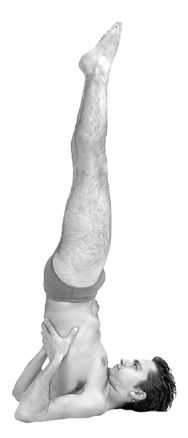Sarvangasana

Sarvangasana (SAHR-vahn-GAH-sah-nah[1]; Sanskrit: सर्वाङ्गासन; IAST: sarvāṅgāsana) or Shoulderstand is an āsana.
Many variations of the Shoulderstand exist, the likely most common to be taught is Supported Shoulderstand (Salamba Sarvangāsana).[2]
Sarvangāsana is nicknamed "queen" or "mother" of all the asanas.[3][4][5]
Etymology
The name in the case of Salamba Sarvāngāsana (Supported Shoulderstand) comes from the Sanskrit words Salamba meaning "supported", Sarva meaning "all" or "every", Anga meaning "limb" or "bodypart",[6] and Āsana meaning "posture"," position", or "seat",[7] thus Salamba Sarvāngasana literally translates to "supported-all-limbs-pose".
Description
Lying on the back with the hands under the mid-back, the legs and lower body are lifted so that the weight of the body is supported on the head, neck, shoulders and upper arms. The gaze is towards the toes and the sagittal and transverse line of the head is perpendicular with the midsagittal and midfrontal line of the body.
Contraindications and cautions
The asana is contraindicated for high blood pressure, whiplash, menstruation, angina, and spinal weakness caused by conditions such as arthritis or osteoporosis.
The weight placed on the cervical spine may mean a risk of neck injury, particularly if the asana is not done properly.
Sequentially related asanas
Sarvangasana is a counter asana for backbends such as Chakrasana.
Halasana is often used to enter and exit Sarvangāsana.
Matsyasana is a counter asana.
See also
References
- ↑ Budilovsky, Joan; Adamson, Eve (2000). The complete idiot's guide to yoga (2 ed.). Penguin. p. 174. ISBN 978-0-02-863970-3. Retrieved 11 April 2011.
- ↑ "Yoga Journal - Supported Shoulderstand". Retrieved 11 April 2011.
- ↑ Francina, Suza (23 March 2003). Yoga and the Wisdom of Menopause: A Guide to Physical, Emotional and Spiritual Health at Midlife and Beyond. HCI. p. 233. ISBN 978-0-7573-0065-3. Retrieved 11 April 2011.
- ↑ Norberg, Ulrica; Lundberg, Andreas (8 April 2008). Hatha Yoga: The Body's Path to Balance, Focus, and Strength. Skyhorse Publishing Inc. p. 106. ISBN 978-1-60239-218-2. Retrieved 11 April 2011.
- ↑ Kappmeier, Kathy Lee; Ambrosini, Diane M. (2006). Instructing hatha yoga. Human Kinetics. p. 265. ISBN 978-0-7360-5209-2. Retrieved 11 April 2011.
- ↑ "Salamba Sarvangāsana - AshtangaYoga.info". Retrieved 11 April 2011.
- ↑ Sinha, S.C. (1 June 1996). Dictionary of Philosophy. Anmol Publications PVT. LTD. p. 18. ISBN 978-81-7041-293-9. Retrieved 9 April 2011.
Further reading
- Iyengar, B. K. S. (1 October 2005). Illustrated Light On Yoga. HarperCollins. ISBN 978-81-7223-606-9. Retrieved 9 April 2011.
- Saraswati, Swami Satyananda (1 August 2003). Asana Pranayama Mudra Bandha. Nesma Books India. ISBN 978-81-86336-14-4. Retrieved 9 April 2011.
- Saraswati, Swami Satyananda (January 2004). A Systematic Course in the Ancient Tantric Techniques of Yoga and Kriya. Nesma Books India. ISBN 978-81-85787-08-4. Retrieved 9 April 2011.
External links
| ||||||||||||||||||||||||||||||||||||||||||||||||||||||||||||||||||||||||